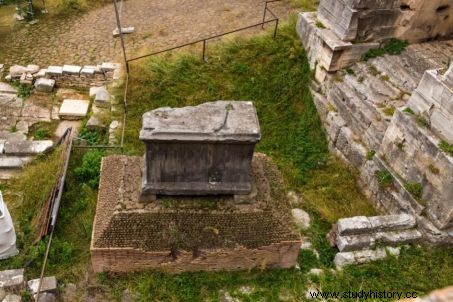In the heart of the Eternal City, archaeologists have discovered a "tomb" concealing a sarcophagus which could have a link with Romulus, the "son of the Wolf", the mythical founder of the city.

An underground chamber has resurfaced next to the Curia-Comitium complex, on the Forum, in Rome. A tuff sarcophagus about 1.40 m long, associated with a circular element, probably an altar were discovered there. A hypogeum that would be linked to Romulus.
The whole Italian press makes its headlines. In Rome, a discovery described as "exceptional " by the director of the Colosseum Archaeological Park, Alfonsina Russo, was carried out in the Roman Forum, close to the Curia-Comitium complex . That is to say, in the heart of the ancient city, the ancient Curia (curia) where the senators met, and the Comitium where the inhabitants of Rome gathered at the beginning of the Republic, in the 6th century century before our era.
A discovery on the Roman Forum a few meters from the famous Lapis niger
The unearthed "tomb" would contain a kind of altar and a tuff sarcophagus about 1.40 meters long found empty. According to the first information provided, the hypogeum dated from the VI e century BC was dug out of the rock, under the Curia entrance stairs.

Entrance to the hypogeum attributed to a possible tomb linked to Romulus. ©Parco Colosseo
Above all, it would be located a few meters from the famous Lapis niger , a tuff stele unearthed in the Forum in 1899, which the Romans associated with Romulus, the legendary founder of Rome. Remember that the foundation of Rome dates back to 753 BC, or between 750 and 700 BC. J.C according to historian Alexandre Grandazzi, one of the best specialists in the matter. Legend has it that the city was founded by Romulus, after he killed his brother Remus, twins raised by a wolf. The stele of Lapis niger, dated VI-V e century BC, is covered with the oldest known Latin inscriptions, some of which refer to a king (rex ).

The Lapis Niger stele today. © Valery Rokhin - Shutterstock
"Only an exceptional person could be buried or honored at this place"
But already at that time, the inhabitants of Rome had forgotten the original meaning of the sanctuary, creating several discordant legends. One - among others - thus indicated that the Lapis niger marked the tomb of Romulus, the "first king of Rome" whose real or legendary existence historians disagree. No wonder then that the discovery of a "tomb" announced on the Forum has fired the imaginations!

The Capitoline Wolf nursing the twins Romulus and Remus. Bronze dated 500 BC © Leemage/AFP
"Without fantasizing too much, this discovery is nevertheless interesting, recognizes the historian Yann Le Bohec, specialist in the Roman world, joined by Sciences et Avenir . Only an exceptional person could be buried or honored here. It was forbidden to bury anyone inside the city limits. Nevertheless, evoking Romulus looks bold to me ..." For Alfonsina Russo, quoted by the Ansa Agency, "it's not a coincidence if this underground altar is placed near the Lapis niger ". According to the latest news, there is also talk of a cenotaph, a monument "in memory of Romulus", rather than a "tomb" strictly speaking.
THE TWINS AND THE WOLF
Romulus and Remus... Popularized by ancient authors such as Livy (-59.17), Ovid (-43.17) or Plutarch (46-125), the existence of two twins suckled by a wolf - figure become the symbol of Rome - has always divided historians. Rather than a historical truth, some authors, such as the German Théodore Mommsen (1817-1903), considered this twinning as the symbol of the double Roman consulship while the Italian Ettore Pais (1856-1939) saw in it the plebeian opposition. -patriciate.
An episode of this legend was brought to light by archeology at the end of the 1980s by a team of scientists, led by the Italian archaeologist Andrea Carandini, who in an incompletely explored area of the Forum discovered a long and deep gash staked large stones. For Carandini, this was indeed the pomoerium, the "sacred furrow" traced by Romulus. The death of Romulus also oscillates between myth and reality. The version most often accepted is that he was killed by angry senators who, after dismembering him, scattered the pieces of his body in different places in the city. A theory that pleads for the absence of a corpse, and therefore of a grave.
With AFP
